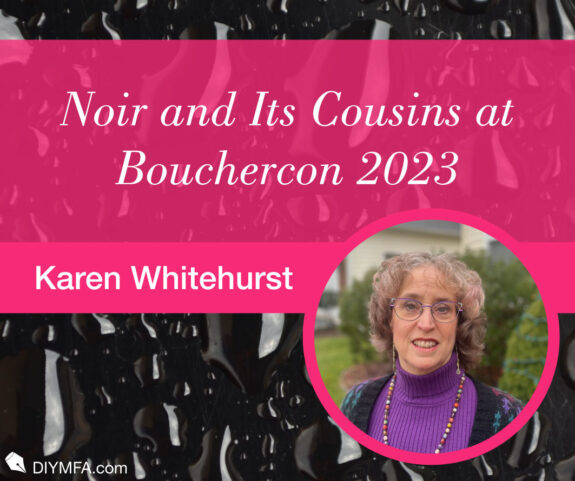Bouchercon is the annual World Mystery Convention held in honor of Anthony Boucher, a writer and editor of mysteries. This convention moves to a different city every year. This year in San Diego, seventeen hundred people attended. In the next few years, Bouchercon will go to Nashville, New Orleans, and Calgary before coming back to Washington, DC in 2027.
Where Malice Domestic promotes the traditional mystery with low levels of sex, violence, and gore, Bouchercon covers all types of mysteries. Agatha Christie lovers rub shoulders with Harlan Coben and Christa Faust fans. I go to both because historical fiction authors and readers will attend, but I go to Bouchercon to get my noir fix. And noir can definitely be historical—whether authors set their stories in the past as Scott Von Doviak in Lowdown Road (1974 Texas) or let their protagonists be haunted by the past as Faye Snowden did to Raven Burns in A Killing Fire.
“The fault, dear Brutus, is not in our stars/But in ourselves.”
Cassius, in Shakespeare’s Julius Caesar, pithily names the source of all problems in noir, less so Gothic and hard-boiled fiction. Perhaps it’s the reason I love those subgenres, even if I don’t, probably can’t, write them.
Let’s discuss noir first. If we’re talking about film, it’s a style. Dark alleys, rain-slicked streets, murky atmosphere, shots down spiral staircases, reflections, shadows, shady characters who come to no good end. In film, think Out of the Past, The Sweet Smell of Success, Odds Against Tomorrow, and L.A. Confidential. That last is neo-noir, but really, was anything shot in daylight?
In fiction, noir has many definitions, and the authors at the panels I attended debated them all. One overrode all others—it always ends badly for everybody. Nobody gets away with it, even if it looks like they have done it. Additionally, in noir, the main character usually is a louse, but generally, she/he/they do bad things to worse people. Finding the truth of the situation is worse than not knowing. Dreamers turn into schemers. This definition goes along with my conception of noir—there’s no easy walk to Easy Street. Both film noir and noir in fiction are full of stupid, corrupted and corruptible, amoral people trying to hit the jackpot, so they can check out of the rat race. It never goes well. Something else I would add—there is no redemption here. History matters, personal history most of all, foreclosing any reclamation.
There was something of a consensus that the cops and PIs are not involved in noir fiction. The authors on the panels agreed noir was crime fiction without them. I beg to differ. Have they read James Ellroy’s La Quartet? Ellroy is completely traditional in this sense—the cops are just the other gang, better armed and funded.
Noir has two close cousins—Gothic and hard-boiled fiction. If I could draw a three-circle Venn diagram, there would be significant overlap amongst the three categories.
Gothic, which these days means we’re talking about the American South, is all about an intense, emotional experience and buried secrets that corrupt everything and everybody they touch. These secrets are the point of overlap with noir because discovering the truth of these secrets is worse than not knowing the source of the corruption. Above all, people are willing to go to extraordinary, violent lengths to keep these secrets.
Faye Snowden made an interesting point here—preachers are always corrupt in Southern Gothic. Don’t believe her? Read David Grubb’s Night of the Hunter. I cannot think of a more corrupt example than Harry “Preacher” Powell, unless it’s Elmer Gantry, but Gantry was a mere crook, not the murderous, hateful, but charming charlatan that is Powell. And definitely watch the film—Charles Laughton directed it, using Expressionism to capture the Gothic feel, and Robert Mitchum played Powell to his rotten worst.
For the record, Gothic literature came from mid-eighteenth century England—think The Monk by Gregory Lewis, which has enough crime, religiosity, and overwrought emotion to last a lifetime and which has never been out of print—to New England, where Nathaniel Hawthorne did well with it (The Scarlet Letter) to the MidAtlantic, where Edgar Allen Poe (The Fall of the House of Usher) ran with it—Baltimore’s NFL team is the Ravens for a reason—and then to its natural landing spot, the Deep South.
Why? Shakespeare wrote that the past is prologue. In Requiem for a Nun, William Faulkner disagreed—“The past is never dead. It’s not even the past.”
The original sin in the South is slavery. Having to grapple with this unresolved past plus things done and left undone in the name of religion, makes Faulkner and Flannery O’Connor easier to understand. Faulkner, who dealt with the horror and costs of slavery underlain by a stern and fervent Protestantism, social transgression, and obsession with death, laid the roadbed for modern Southern Gothic. Flannery O’Conner, herself Catholic and therefore something of a religious outsider in the South, wrestled with secrets, transgression, death, and the grotesque in her work. Religiosity and hypocrisy can combine to corrupt, making the South a fertile setting for terrible crimes, of which murder might be the least. S.A. Cosby and Attica Locke, in addition of Faye Snowden, have brilliantly plowed this ground.
(For more on Faye Snowden’s take on Southern Gothic: https://crimereads.com/southern-gothic-crime-fiction-a-palimpsest-and-primer/ )
If noir’s in the middle, with Gothic on one side, then hard-boiled is on the other side. It overlaps with a cynical narrative voice, a corrupt and vice-ridden world, and a world-weary protagonist who knows the score, but who plows ahead to expose the corruption. The difference? Noir starts with a tepid hope, which is crushed under the bad choices the characters make. Everything gets worse, and nothing works out. In hard-boiled, the protagonist gets out alive, if more shit-stained, more damaged, and the crooks, mostly, end up jailed or dead.
Like Gothic and noir, hard-boiled can be historical or contemporary, but the past is always there to haunt the characters.
It should be no surprise that the PI novel—America’s contribution to crime fiction with Hammett, Chandler, and Macdonald putting murder on the ‘mean streets’—is the backbone of hard-boiled fiction. The private investigator is an archetypal character. She/he/they are always an outsider, always a damaged loner, but the PI knows right from wrong, even when others don’t. Sara Paretsky said at the panel on the enduring popularity of the PI novel: “The individual voice still matters.”
The PI novel has moved a long way from the days of Hammett, Chandler, and Macdonald, whose white male characters, the Continental Op, Philip Marlowe, and Lew Archer, have given way to a broader, more diverse set of PIs, such as Gary Phillip’s Ivan Monk, Sara Paretsky’s V. I. Warshawski, and S. J. Rozan’s Lydia Chin, as well as broader, more diverse crimes and locations. After all, Assassin’s Orbit by John Appel involves Noo Okereke, a sixty-two-year-old PI, investigating a brutal assassination in outer space a couple centuries in the future. While it is more space opera than PI novel, it does show that PIs are far from dead in fiction—the whole point of the Bouchercon panel.
I didn’t just do noir and its cousins at Bouchercon. I went to several history panels, too. I’ll talk about them in the next blog on the biggest mystery convention of the year.

A former college professor, Karen Whitehurst holds a Ph.D. in British history from the University of Virginia. She currently resides in Maryland with one long-suffering husband, three naughty cats, and over one hundred houseplants. A writer of both historical mystery and SF & F, she is currently at work on a mystery set in 18th century England during the Gordon Riots.
For more information, visit her website.







